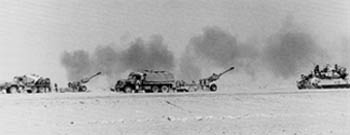
American Howitzers Supporting the French Attack on Objective ROCHAMBEAU
Three commands held the eastern one-third of the front. Joint Forces Command North, made up of formations from Egypt, Syria, and Saudi Arabia and led by His Royal Highness Lt. Gen. Prince Khalid ibn Sultan, held the portion of the line east of Vll Corps. To the right of these allied forces stood Lt. Gen. Walter E. Boomer's I Marine Expeditionary Force, which had the 1st (or Tiger) Brigade of the Army's 2d Armored Division as well as the 1st and 2d Marine Divisions. Joint Forces Command East on the extreme right, or eastern, flank anchored the line at the Persian Gulf. This organization consisted of units from all six member states of the Gulf Cooperation Council. Like Joint Forces Command North, it was under General Khalid's command.1
After thirty-eight days of continuous air attacks on targets in Iraq and Kuwait, President George H. Bush directed Central Command to proceed with the ground offensive. General Schwarzkopf unleashed all-out attacks against Iraqi forces very early on 24 February at three points along the allied line. In the far west the French 6th Light Armored and the 101st Airborne Divisions started the massive western envelopment with a ground assault to secure the allied left flank and an air assault to establish forward support bases deep in Iraqi territory. In the approximate center of the allied line, along the Wadi al Batin, Maj. Gen. John H.
174
Tilelli, Jr.'s 1st Cavalry Division attacked north into a concentration of Iraqi divisions, whose commanders remained convinced that the coalition would use that and several other wadies as avenues of attack. In the east two Marine divisions, with the Army's Tiger Brigade, and coalition forces under Saudi command attacked north into Kuwait. Faced with major attacks from three widely separated points, the Iraqi command had to begin its ground defense of Kuwait and the homeland by dispersing its combat power and logistical capability.2
But before they reached As Salman, the French found some very surprised outposts of the Iraqi 45th Infantry Division. General Janvier immediately sent his missile-armed Gazelle attack helicopters against the dug-in enemy tanks and bunkers. Late intelligence reports had assessed the 45th as only about 50-percent effective after weeks of intensive coalition air attacks and psychological operations, an assessment soon confirmed by feeble resistance. After a brief battle that cost them two dead and twenty-five wounded, the French held 2,500 prisoners and controlled the enemy division area, now renamed ROCHAMBEAU. Janvier pushed his troops on to As Salman, which they took without opposition and designated Objective WHITE. The French consolidated WHITE and waited for an Iraqi counterattack that never came. The allied left flank was secure.3

American Howitzers Supporting the French Attack on Objective ROCHAMBEAU
175
Maj. Gen. James H. Johnson, Jr.'s 82d Airborne Division carried out a mission that belied its "airborne" designation. While the division's 2d Brigade moved with the French, its two remaining brigades, the 1st and 3d, trailed the advance and cleared a two-lane highway into southern Iraq-main supply route TEXAS-for the troops, equipment, and supplies supporting the advance north.
The XVIII Airborne Corps' main attack, led by Maj. Gen. J. H. Binford Peay III's 101st Airborne Division, was scheduled for 0500, but fog over the objective forced a delay. While the weather posed problems for aviation and ground units, it did not abate direct support fire missions. Corps artillery and rocket launchers poured fire on objectives and approach routes. At 0705 Peay received the word to attack. Screened by Apache and Cobra attack helicopters, 60 Black Hawk and 40 Chinook choppers of XVIII Airborne Corps' 18th Aviation Brigade began lifting the 1st Brigade into Iraq. The initial objective was the forward operating base COBRA, a point some 110 miles into Iraq. A total of 300 helicopters ferried the 101st's troops and equipment into the objective area in one of the largest helicopter-borne operations in military history.4
Wherever they went in those initial attacks, Peay's troops achieved tactical surprise over the scattered and disorganized foe. By midafternoon they had a fast-growing group of stunned prisoners in custody and were expanding COBRA into a major refueling point 20 miles across to support subsequent operations. Heavy Chinook helicopters lifted artillery pieces and other weapons into COBRA, as well as fueling equipment and building materials to create a major base. From the Saudi border, XVIII Corps support command units drove 700 high-speed support vehicles north with the fuel, ammunition, and supplies to support a drive to the Euphrates River.5
As soon as the 101st secured COBRA and refueled the choppers, it continued its jump north. By the evening of the twenty-fourth its units had cut Highway 8, about 170 miles into Iraq. Peay's troops had now closed the first of several roads connecting Iraqi forces in Kuwait with Baghdad.6
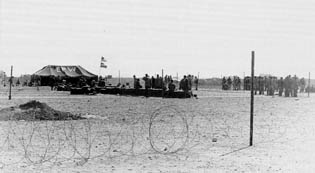
Prisoner-of-War Cage at Forward Operating Base COBRA
176
Spearhead units were advancing much faster than expected. To keep the momentum of the corps intact, General Luck gave subordinate commanders wider freedom of movement. He became their logistics manager, adding assets at key times and places to maintain the advance. But speed caused problems for combat support elements. Tanks that could move up to 50 miles per hour were moving outside the support fans of artillery batteries that could displace at only 25 to 30 miles per hour. Luck responded by leapfrogging his artillery battalions and supply elements, a solution which cut down on fire support, since only half the pieces could fire while the other half raced forward. As long as Iraqi opposition remained weak, the risk was acceptable.7
In XVIII Corps' mission of envelopment, the 24th Infantry Division had the central role of blocking the Euphrates River valley to prevent the escape north of Iraqi forces in Kuwait and then attacking east in coordination with VII Corps to defeat the armor-heavy divisions of the Republican Guard Forces Command. Maj. Gen. Barry R. McCaffrey's division had come to the theater better prepared for combat in the desert than any other in Army Central Command. Designated a Rapid Deployment Force division a decade earlier, the 24th combined the usual mechanized infantry division components-an aviation brigade and three ground maneuver brigades, plus combat support units-with extensive desert training and desert-oriented medical and water purification equipment.
When the attack began, the 24th was as large as a World War I division, with 25,000 soldiers in thirty-four battalions. Its 241 Abrams tanks and 221 Bradley fighting vehicles provided the necessary armor punch to penetrate Republican Guard divisions. But with 94 helicopters, and over 6,500 wheeled and 1,300 other tracked vehicles-including 72 self-propelled artillery pieces and 9 multiple rocket launchers-the division had given away nothing in mobility and firepower.8
General McCaffrey began his division attack at 1500 with three subordinate units on line, the 197th Infantry Brigade on the left, the 1st Brigade in the center, and the 2d Brigade on the right. Six hours before the main attack the 2d Squadron, 4th Cavalry, had pushed across the border and scouted north along the two combat trails that the division would use, X-RAY on the left and YANKEE on the right. The reconnaissance turned up little evidence of the enemy, and the rapid progress of the division verified the scouts' reports. McCaffrey's brigades pushed about 50 miles into Iraq, virtually at will, and reached a position roughly adjacent to Objective WHITE in the French sector and a little short of forward operating base COBRA in the 101sts sector.
In their movement across the line of departure, and whenever not engaging enemy forces, battalions of the 24th Division generally moved in "battle box" formation. With a cavalry troop screening 5 to 10 miles to the front, four companies, or multi-platoon task forces, dispersed to form corner positions. Heavier units of the battalion-whether tanks or Bradleys-occupied one or both of the front corners. One company, or
177
smaller units, advanced outside the box to provide flank security. The battalion commander placed inside the box the vehicles carrying ammunition, fuel, and water needed to continue the advance in jumps of about 40 miles. The box covered a front of about 4 to 5 miles and extended about 15 to 20 miles front to rear.9
Following a screen of cavalry and a spearhead of the 1st and 4th Battalions, 64th Armor, McCaffrey's division continued north, maintaining a speed of 25 to 30 miles per hour. In the flat terrain the 24th kept on course with the aid of long-range electronic navigation, a satellite reading triangulation system in use for years before DESERT STORM. Night did not stop the division, thanks to more recently developed navigation technology. Unit commanders and vehicle drivers used image-enhancement scopes and goggles, and searched for targets with infrared- and thermal-imaging systems sensitive to personnel and vehicle heat signatures. Small units used hand-held Trimpack and Magellan global positioning systems. Around midnight McCaffrey stopped his brigades on a line about 75 miles inside Iraq. Like the rest of XVIII Airborne Corps, the 24th Division had established positions deep inside Iraq against surprisingly light opposition.
Command and control, as well as protection against fratricide, were accomplished with the transmitting device Budd Light, named for its inventor, Henry C. "Budd" Croley of the Army Materiel Command. Consisting of infrared light-emitting diodes snapped onto the tops of commercial batteries, Budd Lights were placed on vehicle antennas in varying numbers to distinguish command or guide vehicles from others. Easily visible up to 1.2 miles through night vision goggles, the purplish glow of 10,000 Budd Lights enabled the 24th Division and other units to move safely at night. Other safety measures included marking all coalition vehicles with inverted V's, rather than the insignia of each participating country, in a reflective infrared paint.10
The VII Corps had the mission of finding, attacking, and destroying the heart of President Saddam Hussein's ground forces, the armor-heavy Republican Guard divisions. In preparation for that, Central Command had built up General Franks' organization until it resembled a mini-army more than a traditional corps. The "Jayhawk" corps of World War 11 fame had a 3d Infantry Division (Mechanized) brigade attached to the 1st Armored Division and four field artillery brigades, the 42d, 75th, 142d, and 210th. To make deep attacks, to ferry infantry units into trouble spots, and to help armor crews kill tanks, the corps also had the 11th Aviation Brigade. Franks' command numbered more than 142,000 soldiers, compared with Luck's 116,000. To keep his troops moving and fighting, Franks used more than 48,500 vehicles and aircraft, including 1,587 tanks, 1,502 Bradleys and armored personnel carriers, 669 artillery pieces, and 223 attack helicopters. For every day of offensive operations, the corps needed 5.6 million gallons of fuel, 3.3 million gallons of water, and 6,075 tons of ammunition.11
178
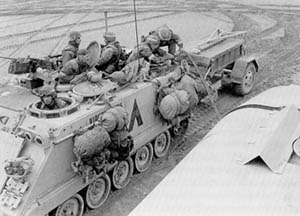
Refueling an Armored Personnel Carrier During the Attack
The plan of advance for VII Corps paralleled that of Luck's corps to the west: a thrust north into Iraq, a massive turn to the right, and then an assault to the east into Kuwait. Because Franks' sector lay east of Luck's-in effect, closer to the hub of the envelopment wheel-VII Corps had to cover less distance than XVIII Airborne Corps. But intelligence reports and probing attacks into Iraqi territory in mid-February had shown that VII Corps faced a denser concentration of enemy units than did XVIII Corps farther west. Once the turn to the right was complete, both corps would coordinate their attacks east so as to trap Republican Guard divisions between them and then press the offensive along their wide path of advance until Iraq's elite units either surrendered or were destroyed.
General Schwarzkopf originally had planned the VII Corps attack for 25 February. But XVIII Corps advanced so fast against such weak opposition that he moved up his armor attack by fourteen hours. Within his own sector Franks planned a feint and envelopment much like the larger overall strategy. On VII Corps' right, along the Wadi al Balin, the 1st Cavalry Division would make a strong, but limited, attack directly to its front. While Iraqi units reinforced against the 1st, Franks would send two divisions through berms and mines on the corps' right and two more divisions on an "end around" into Iraq on the corps' left.
On 24 February the 1st Cavalry Division crossed the line of departure and hit the Iraqi 27th Infantry Division. That was not their first meeting. General Tilelli's division had actually been probing the Iraqi defenses for some time. As these limited thrusts continued in the area that became known as the Ruqi Pocket, Tilelli's men found and destroyed elements of five Iraqi divisions, evidence that the 1st succeeded in its theater reserve mission of drawing and holding enemy units.
The main VII Corps attack, coming from farther west, caught the defenders by surprise. At 0538 Franks sent Maj. Gen. Thomas G. Rhame's 1st Infantry Division forward. The division plowed through the berms and hit trenches full of enemy soldiers. Once astride the trench lines, it turned the plow blades of its tanks and combat earthmovers along the Iraqi defenses and, covered by fire from Bradley crews, began to fill them in. The 1st neutralized 10 miles of Iraqi lines this way, killing or capturing all of the defenders without losing one soldier, and proceeded to cut twenty-
179
four safe lanes through the minefields in preparation for passage of the British 1st Armored Division. On the far left of the corps sector, and at the same time, the 2d Armored Cavalry swept around the Iraqi obstacles and led 1st and 3d Armored Divisions into enemy territory.12
The two armored units moved rapidly toward their objective, the town of A1 Busayyah, site of a major logistical base about 80 miles into Iraq. The 1st Armored Division on the left along XVIII Corps' boundary and the 3d Armored Division on the right moved in compressed wedges 15 miles wide and 30 miles deep. Screened by cavalry squadrons, the divisions deployed tank brigades in huge triangles, with artillery battalions between flank brigades and support elements in nearly 1,000 vehicles trailing the artillery.
Badly mauled by air attacks before the ground operation and surprised by Franks' envelopment, Iraqi forces offered little resistance. The 1st Infantry Division destroyed two T-55 tanks and five armored personnel carriers in the first hour and began taking prisoners immediately. Farther west, the 1st and 3d Armored Divisions quickly overran several small infantry and armored outposts. Concerned that his two armored units were too dispersed from the 1st Infantry Division for mutual reinforcement, Franks halted the advance with both armored elements on the left only 20 miles into Iraq. For the day, VII Corps rounded up about 1,300 of the enemy.13
In the east Marine Central Command (MARCENT) began its attack at 0400. General Boomer's I Marine Expeditionary Force aimed directly at its ultimate objective, Kuwait City. The Army's Tiger Brigade, 2d Armored Division, and the 1st and 2d Marine Divisions did not have as far to go to reach their objective as did Army units to the west-Kuwait City lay between 35 and 50 miles to the northeast, depending on the border crossing point-but they faced more elaborate defense lines and a tighter concentration of the enemy. The 1st Marine Division led from a position in the vicinity of the elbow of the southern Kuwait border, and immediately began breaching berms and rows of antitank and antipersonnel mines and several lines of concertina wire. The unit did not have Abrams tanks, but its M60A3 tanks and TOW-equipped high mobility multipurpose wheeled vehicles, supported by heavy artillery, proved sufficient against Iraqi T-55 and T-62 tanks. After the marines destroyed two tanks in only a few minutes, 3,000 Iraqis surrendered.14
At 0530 the 2d Marine Division, with Col. John B. Sylvester's Tiger Brigade on its west flank, attacked in the western part of the Marine Central Command sector. The Army armored brigade, equipped with MlA1 Abrams tanks, gave the marines enough firepower to defeat any armored units the Iraqis put between Boomer's force and Kuwait City. The first opposition came from a berm line and two mine belts. Marine M60A1 tanks with bulldozer blades quickly breached the berm, but the mine belts required more time and sophisticated equipment. Marine engineers used mine clearing line charges and M60A1 tanks with forked
180-181
Map 13 Ground War Situation 24 February 1991
182
mine plows to clear six lanes in the division center, between the Umm Qudayr and A1 Wafrah oil fields. By 1615 the Tiger Brigade had passed the mine belts. As soon as other units passed through the safe lanes, the 2d Marine Division repositioned to continue the advance north, with regiments on the right and in the center and the Tiger Brigade on the left tying in with the allied forces.15
To maintain command and control and to measure progress beyond the mines, Boomer's staff had drawn a series of parallel east-west phase lines, most of which followed power lines or desert trails. Reaching daily objectives on the approach to Kuwait City, the 2d Marine Division would cross phase lines RED, HORSE, WOLF, BEAR, and Ox. The last two phase lines were modern multilane highways leading to Kuwait City. Navigation between phase lines became easier after the Iraqis ignited oil fields, for these became reliable landmarks.16
Moving ahead a short distance to phase line RED near the end of the day, the 2d Marine Division captured intact the Iraqi 9th Tank Battalion with thirty-five T-55 tanks and more than 5,000 men. Already on the first day of ground operations the number of captives had become a problem in the Marine sector. After a fight for A1 Jaber airfield, during which the 1st Marine Division destroyed twenty-one tanks, another 3,000 prisoners were seized. By the end of the day the I Marine Expeditionary Force had worked its way about 20 miles into Kuwait and taken nearly 10,000 Iraqi prisoners.17
In the early morning darkness of the same day, General McCaffrey put his 24th Division in motion toward its first major objective Following close air support and artillery fires, the division's 197th Brigade attacked at 0300 toward Objective BROWN in the western part of the division sector. Instead of determined opposition, the brigade found hungry prisoners, dazed by the heavy artillery preparation. By 0700 the 197th had cleared the area around BROWN and established blocking positions to the east and west along a trail, which was then being improved to serve as XVIII Corps main supply route VIRGINIA. Six hours later the division's 2d Brigade followed its own artillery fires and attacked Objective GREY on the right, encountering no enemy fire
183
and taking 300 prisoners. After clearing the area, the brigade set blocking positions to the east.19
At 1450, with the 2d Brigade on GREY, the 1st Brigade moved northwest into the center of the division sector and then angled to the division right, attacking Objective RED directly north of GREY Seven hours later the brigade had cleared the RED area, set blocking positions to the east and north, and processed 200 captives. To the surprise of all, the 24th Division had taken three major objectives and hundreds of men in only nineteen hours while meeting weak resistance from isolated pockets of Iraqi soldiers from the 26th and 35th Infantry Divisions. By the end of the day XVIII Airborne Corps had advanced in all division sectors to take important objectives, establish a functioning forward operating base, place brigade size blocking forces in the Euphrates River valley, and capture thousands of prisoners of war-at a cost of two killed in action and two missing.20
In Vll Corps General Franks faced two problems. The British 1st Armored Division, one of the units he had to have when he met the Republican Guard armored force, had begun passage of the mine breach cut by the 1st Infantry Division at 1200 on the twenty-fifth, and would not be completely through for several hours, possibly not until the next day. With the 1st and 3d Armored Divisions along the western edge of the corps sector, and the British not yet inside Iraq, the 1st Infantry and 1st Cavalry Divisions lay vulnerable to an armored counterattack.
A more troubling situation had developed along Vll Corps' right flank. The commitment of some coalition contingents had concerned General Schwarzkopf months before the start of the ground war. Worried about postwar relations with Arab neighbors, some Arab members of the coalition had expressed reluctance to attack Iraq or even enter Kuwait. If enough of their forces sat out the ground phase of the war, the entire mission of liberating Kuwait might fail. To prevent such a disaster, Schwarzkopf had put the 1st Cavalry Division next to coalition units and gave the division the limited mission of conducting holding attacks and standing by to reinforce allies on the other side of the Wadi al Batin. If Joint Forces Command North performed well, the division would be moved from the corps boundary and given an attack mission. Action on the first day of the ground war bore out the wisdom of holding the unit ready to reinforce allies to the east. Syrian and Egyptian forces had not moved forward, and a huge gap had opened in the allied line. Central Command notified the 2d Armored Cavalry to prepare to assist the 1st Cavalry Division in taking over the advance east of the Wadi al Batin.21
But Franks could not freeze his advance indefinitely. The Vll Corps had to press the attack where possible, and that meant on the left flank. Maj. Gen. Ronald H. Griffith's 1st Armored Division and Maj. Gen. Paul E. Funk's 3d Armored Division resumed their advance north shortly after daybreak. Griffith's troops made contact first, with outpost units of the Iraqi 26th Infantry Division, and turned on the enemy the tactical sequence that brought success throughout the campaign. With the 1st
184-185
Map 14 Ground War Situation 25 February 1991
186
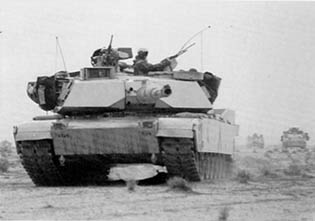
M1A1 Tank of 3d Armored Division Advancing North
Armored Division still about 35 to 40 miles away from its objective, close air support strikes began, followed by attack helicopter strikes. As the division closed to about 10 to 15 miles, artillery, rocket launchers, and tactical missile batteries delivered preparatory fires. As division lead elements came into visual range, psychological operations teams broadcast surrender appeals. If the Iraqis fired on the approaching Americans, the attackers repeated artillery, rocket, and missile strikes. In the experience of the 1st Armored Division, that sequence was enough to gain the surrender of most Iraqi Army units in a given objective. Only once did the Iraqis mount an attack after a broadcast, and in that instance a 1st Armored Division brigade destroyed forty to fifty tanks and armored personnel carriers in ten minutes at a range of 1.2 miles.22
By late morning of 25 February Joint Forces Command North had made enough progress to allow VII Corps and Marine Central Command on the flanks to resume their advance. That afternoon and night in the 1st Infantry Division sector, the Americans expanded their mine breach and captured two enemy brigade command posts and the 26th Infantry Division command post, with a brigadier general and complete staff. Behind them, the British 1st Armored Division made good progress through the mine breach and prepared to turn right and attack the Iraqi 52d Armored Division. 23
Approaching Al Busayyah in early afternoon, the 1st Armored Division directed close air support and attack helicopter sorties on an Iraqi brigade position, destroying artillery pieces, several vehicles, and taking nearly 300 prisoners. That night the 2d Armored Cavalry and 3d Armored Division oriented east and encountered isolated enemy units under conditions of high winds and heavy rains.24
With the allied advance well under way all along the line, a U.S. Navy amphibious force made its final effort to convince the Iraqi command authority that Central Command would launch a major over-the-beach assault into Kuwait. Beginning late on 24 February and continuing over the following two days, the Navy landed the 7,500-man 5th Marine Expeditionary Brigade at Al Mish'ab, Saudi Arabia, about 28 miles south of the border with Kuwait. Once ashore, the 5th became the reserve for Joint Forces Command East. Later investigation showed that the presence of the amphibious force in Persian Gulf waters before the ground war had forced the Iraqi command to hold in Kuwait as many as four divisions to meet an amphibious assault that never materialized.25
187
At daybreak on 25 February Iraqi units made their first counterattack in the Marine sector, hitting the 2d Marine Division right and center. While Marine regiments fought off an effort that they named the "Reveille Counterattack," troops of the Tiger Brigade raced north on the left. In the morning the brigade cleared one bunker complex and destroyed seven artillery pieces and several armored personnel carriers. After a midday halt, the brigade cleared another bunker complex and captured the Iraqi 116th brigade commander among a total of 1,100 prisoners of war for the day. In the center of the corps sector the marines overran an agricultural production facility, called the "Ice Cube Tray" because of its appearance to aerial observers.26
By the end of operations on 25 February General Schwarzkopf for the second straight day had reports of significant gains in all sectors. But enemy forces could still inflict damage, and in surprising ways and places. The Iraqis continued their puzzling policy of setting oil fires- well over 200 now blazed out of control-as well as their strategy of punishing Saudi Arabia and provoking Israel. They launched four Scuds, one of which slammed into a building housing American troops in Dhahran. That single missile killed 28 and wounded more than 100, causing the highest one-day casualty total for American forces in a war of surprisingly low losses to date.27
After refueling in the morning, all three brigades of the 24th moved out at 1400 toward the Iraqi airfields at Jabbah and Tallil. The 1st Brigade went north, then east about 40 miles to take a battle position in the northeast corner of the corps sector; the 2d Brigade moved 35 miles north to a position along the eastern corps boundary and then continued its advance another 25 miles until it was only 15 miles south of Jahbah; and the 197th Brigade went northeast about 60 miles to a position just south of Tallil. Meanwhile, the 3d Armored Cavalry screened to the east on the division's south flank.
In these attacks the 24th encountered the heaviest resistance of the war. The Iraqi 47th and 49th Infantry Divisions, the Nebuchadnezzar Division of the Republican Guard, and the 26th Commando Brigade took heavy fire but stood and fought. The 1st Brigade took direct tank and artillery fire for four hours. For the first time in the advance the terrain gave the enemy a clear advantage. McCaffrey's troops found Iraqi artillery
188
and automatic weapons dug into rocky escarpments reminiscent of the Japanese positions in coral outcroppings on Pacific islands that an earlier generation of 24th Infantry Division soldiers had faced. But Iraqi troops were not as tenacious in defense as the Japanese had been, and the 24th had much better weapons than its predecessors. American artillery crews located enemy batteries with their Firefinder radars and returned between three and six rounds for every round of incoming. With that advantage, American gunners destroyed six full Iraqi artillery battalions.28
In the dust storm and darkness American technological advantages became clearer still. Thermal-imaging systems in tanks, Bradleys, and attack helicopters worked so well that crews could spot and hit Iraqi tanks at up to 4,000 meters (2.5 miles) before the Iraqis even saw them. American tank crews were at first surprised at their one-sided success, then exulted in the curious result of their accurate fire: the "pop-top" phenomenon. Because Soviet-made tank turrets were held in place by gravity, a killing hit blew the turret completely off. As the battle wore on, the desert floor became littered with pop-tops. A combination of superior weaponry and technique-precise Abrams tank and Apache helicopter gunnery, 25-mm. automatic cannon fire from the Bradleys, overwhelming artillery and rocket direct support and counterbattery fire, and air superiority-took the 24th Division through enemy armor and artillery units in those "valley battles" and brought Iraqi troops out of their bunkers and vehicles in droves with hands raised in surrender. After a hard but victorious day and night of fighting, the 2d Brigade took its position by 2000 on the twenty-sixth. The other two brigades accomplished their missions by dawn.29
In VII Corps' sector on 26 February the 1st Armored Division fired heavy artillery and rocket preparatory fires into A1 Busayyah shortly after dawn, and by noon had advanced through a sandstorm to overrun the small town. In the process, General Griffith's troops completed the destruction of the Iraqi 26th Infantry Division and, once in the objective area, discovered they had taken the enemy VII Corps headquarters and a corps logistical base as well. More than 100 tons of munitions were captured and large numbers of tanks and other vehicles destroyed. The 1st Armored Division pressed on, turning northeast and hitting the Tawakalna Division of the Republican Guard. Late that night Griffith mounted a night assault on the elite enemy unit and, in fighting that continued the next day, killed 30 to 35 tanks and 10 to 15 other vehicles.30
In the 3d Armored Division sector Funk's men crossed the intercorps phase line SMASH just after daylight and attacked Objective COLLINS, east of Al Busayyah. Through the evening the division fought its toughest battles in defeating elements of the Tawakalna Division. With the capture of COLLINS and nearby enemy positions, VII Corps reached the wheeling point in its advance. From here, General Franks' divisions turned east and assaulted Republican Guard strongholds. Meanwhile, the 1st Infantry Division was ordered north from its position inside the mine
189
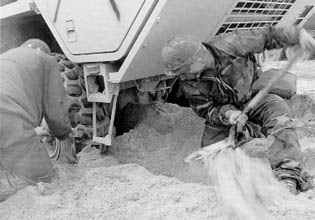
1st Armored Division Soldiers Digging Out a Heavy Equipment Transporter
belt breach. As the attack east began, VII Corps presented in the northern part of its sector a front of three divisions and one regiment: the 1st Armored Division on the left (north); the 3d Armored Division, the 2d Armored Cavalry, and the 1st Infantry Division on the right (south). Farther south, the British 1st Armored Division, with over 7,000 vehicles, cleared the mine breach at 0200 and deployed to advance on a separate axis into Objective WATERLOO, and on to the juncture of phase line SMASH and the corps boundary. From ARCENT headquarters came word that General Luck's corps would soon be even stronger. At 0930 the ARCENT commander, Lt. Gen. John J. Yeosock, released 1st Cavalry Division from its theater reserve role to VII Corps.31
In the early afternoon Col. Leonard D. Holder, Jr.'s 2d Armored Cavalry advanced east of COLLINS in a shamal. The regiment, screening in front of 1st Infantry Division, had just arrived from the mine belt along the Saudi border that it had breached the first day of the ground war. The cavalrymen had only a general idea of the enemy's position. The Iraqis had long expected the American attack to come from the south and east and were now frantically turning hundreds of tanks, towed artillery pieces, and other vehicles to meet the onslaught from the west. On the Iraqi side, unit locations were changing almost by the minute. As Holder's men neared phase line TANGERINE, 20 miles east of COLLINS, one of the cavalry troops received fire from a building on the 69 Easting, a north-south line on military maps. The cavalrymen returned fire and continued east. More enemy fire came in during the next two hours and was immediately returned. Just after 1600 the cavalrymen found T-72 tanks in prepared positions at 73 Easting. The regiment used its thermal imaging equipment to deadly advantage, killing every tank that appeared in its sights. But this was a different kind of battle than Americans had fought so far. The destruction of the first tanks did not signal the surrender of hundreds of Iraqi soldiers. The tanks kept coming and fighting.32
The reason for the unusually determined enemy fire and large number of tanks soon became clear. The cavalrymen had found two Iraqi divisions willing to put up a hard fight, the 12th Armored Division and the Tawakalna Division. Holder's regiment found a seam between the two divisions, and for a time became the only American unit obviously outnumbered and outgunned during the ground campaign. But, as the 24th Division had found in its valley battles, thermal-imaging equipment cut through the dust storm to give gunners a long-range view of enemy vehicles and grant the fatal first-shot advantage. For four hours Holder's men
190-191
Map 15 Ground War Situation 26 February 1991
192
killed tanks and armored personnel carriers while attack helicopters knocked out artillery batteries. When the battle of 73 Easting ended at 1715, the 2d Armored Cavalry had destroyed at least 29 tanks and 24 armored personnel carriers, as well as numerous other vehicles and bunkers, and taken 1,300 prisoners. That night, the 1st Infantry Division passed through Holder's cavalrymen and continued the attack east.33
Farther to the south, the British 1st Armored Division attacked eastward through the 48th Infantry and 52d Armored Divisions and remnants of other Iraqi units trying to withdraw north. This attack marked the start of nearly two days of continuous combat for the British, some of the toughest fighting of the war. In the largest of this series of running battles, the British destroyed 40 tanks and captured an Iraqi division commander.34
To the east, the Marine advance resumed on the twenty-sixth with the two Marine divisions diverging from their parallel course of the first two days. The 2d Marine Division and the Army's Tiger Brigade, 2d Armored Division, continued driving directly north, while the 1st Marine Division turned northeast toward Kuwait International Airport. The Army tankers headed toward Mutla Ridge, an extended upfold only about 25 feet high. The location next to the juncture of two multilane highways in the town of Al Jahrah, a suburb of Kuwait City, rather than the elevation, had caught General Boomer's attention weeks earlier. By occupying the ridge the brigade could seal a major crossroads and slam the door on Iraqi columns escaping north to Baghdad.35
The brigade advanced at 1200 with the 3d Battalion, 67th Armor, in the lead. Approaching Mutla Ridge, the Americans found a minefield and waited for the plows to cut a safety lane. On the move again, the brigade began to find enemy bunker complexes and dug-in armored units. Enemy tanks, almost all of the T-55 type, were destroyed wherever encountered, and most bunkers yielded still more prisoners. During a three-hour running battle in the early evening, Tiger tankers cleared the Mutla police post and surrounding area. Moving up and over Mutla Ridge, the 67th's tanks found and destroyed numerous antiaircraft artillery positions. Perimeter consolidation at the end of the day's advance was complicated and delayed by the need to process an even larger number of prisoners of war than the day before: 1,600.36
The Tiger Brigade now controlled the highest point for hundreds of miles in any direction. When the troops looked down on the highways from Mutla Ridge, they saw the largest target an armored brigade had probably ever seen. The previous night Air Force and Navy aircraft had begun destroying all vehicles spotted fleeing from Kuwait. Now the brigade added its firepower to the continuous air strikes. On the "Highway of Death" hundreds of burning and exploding vehicles of all types, including civilian automobiles, were visible. Hundreds more raced west out of Kuwait City unknowingly to join the deadly traffic jam. Here and there knots of drivers, Iraqi soldiers, and refugees fled into the desert because of the inferno of bombs, rockets, and tank fire.
193
These lucky ones managed to escape and join the ranks of the growing army of prisoners.37
At the close of allied operations on 26 February a total of twenty-four Iraqi divisions had been defeated. In all sectors the volume of prisoners continued to grow and clog roads and logistical areas. Iraqi soldiers surrendered faster than Central Command could count them, but military police units estimated that the total now exceeded 30,000.38
The day ended with at least one other major logistical problem. The 24th Division had moved so fast in two days that fuel trucks had difficulty keeping up. After taking positions on the night of the twenty-sixth, the lead tanks had less than 100 gallons of fuel on board. Brigade commanders had the fuel, but lead elements were not sure where to rendezvous in the desert. The problem was solved by the kind of unplanned actions on which victories often turn. A small number of junior officers took the initiative to lead tank truck convoys across the desert at night with only a vague idea of where either brigade fuel supplies or needy assault units were located. By approaching whatever vehicles came into view and asking for unit identity, those leaders managed to refuel division vehicles by midnight.39
Following a four-hour rest, the 2d Brigade attacked at midnight, seized a position just south of Jallbah by 0200 on the twenty-seventh, and stayed there while preparatory fires continued to fall on the airfield. At 0600 the 1st Brigade moved east toward the airfield, stopped short, and continued firing on Iraqi positions. At the same time, the 2d Brigade resumed the attack with three infantry-armor task forces and crashed through a fence around the runways. Although the airfield had been hit by air strikes for six weeks and a heavy artillery preparation by five battalions of XVIII Corps' 212th Field Artillery Brigade, Iraqi defenders were still willing to fight. Most Iraqi fire was ineffectual small arms, but armor piercing rounds hit two Bradleys, killing two men of the 1st Battalion, 64th Armor, and wounding several others in the 3d Battalion, 15th Infantry. As nearly 200 American armored vehicles moved across the air-
194
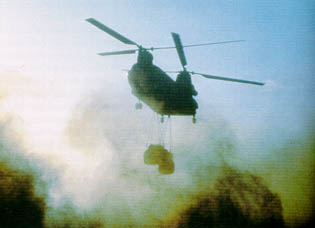
Chinook Helicopter Delivering Supplies to XVIII Corps Troops on
the Move
field knocking out tanks, artillery pieces, and even aircraft, Iraqis began to surrender in large numbers. By 1000 the Jahbah airfield was secure.40
At midday heavy artillery and rocket launcher preparations, followed by twenty-eight close air sorties, were directed on the Tallil airfield. As the fires lifted, the 197th Brigade advanced across the cratered runways and through weaker resistance than that at Jahbah. But like the 2d Brigade at Jahbah, the 197th killed both armored vehicles and aircraft on the ground and found large numbers of willing prisoners.41
As the 197th Brigade assaulted Tallil, General McCaffrey realigned his other units to continue the attack east centering on Highway 8. The 1st Brigade took the division left (north) sector, tying in with the 101st Airborne Division. The 2d Squadron, 4th Cavalry, the 24th's reconnaissance unit, moved east from the Hawr al Malih lake area to set up a tactical assembly area behind the 1st Brigade. The 2d Brigade left its newly won airfield position and assumed the center sector of the division front. The 3d Armored Cavalry took the right sector, tying in with VII Corps to the south. With the 24th Division now oriented east after its northern advance of the first two days, a new series of phase lines was drawn between the Tallil airfield and the Ar Rumaylah oil fields, just southwest of Al Basrah. From the line of departure east of the Jahbah airfield, McCaffrey's units would advance across phase lines AXE, KNIFE, VICTORY, and CRUSH.42
The run down the highway showed more clearly than any other episode the weaknesses of Iraqi field forces and the one-sidedness of the conflict. Through the afternoon and night of 27 February the tankers, Bradley gunners, and helicopter crews and artillerymen of the 1st and 4th Battalions, 64th Armor, fired at hundreds of vehicles trying to redeploy to meet the new American attack from the west, or simply to escape
195
north across the Euphrates River valley and west on Highway 8. With no intelligence capability left to judge the size or location of the oncoming American armored wedges and attack helicopter swarms, as well as insufficient communications to coordinate a new defense, Iraqi units stumbled into disaster. Unsuspecting drivers of every type of vehicle, from tanks to artillery prime movers and even commandeered civilian autos, raced randomly across the desert or west on Highway 8 only to run into General McCaffrey's firestorm. Some drivers, seeing vehicles explode and burn, veered off the road in vain attempts to escape. Others stopped, dismounted, and walked toward the Americans with raised hands. When the division staff detected elements of the Hammurabi Division of the Republican Guard moving across the 24th's front, McCaffrey concentrated the fire of nine artillery battalions and an Apache battalion on the once elite enemy force. At dawn the next day, the twenty-eighth, hundreds of vehicles lay crumpled and smoking on Highway 8 and at scattered points across the desert. The 24th's lead elements, only 30 miles west of A1 Basrah, set up a hasty defense along phase line VICTORY.43
The 24th Division's valley battles of 25-27 February rendered ineffective all Iraqi units encountered in the division sector and trapped most of the Republican Guard divisions to the south while VII Corps bore into them from the west, either blasting units in place or taking their surrender. In its own battles the 24th achieved some of the most impressive results of the ground war. McCaffrey's troops had advanced 190 miles into Iraq to the Euphrates River, then turned east and advanced another 70 miles, all in four days. Along the way they knocked out over 360 tanks and armored personnel carriers, over 300 artillery pieces, over 1,200 trucks, 500 pieces of engineer equipment, 19 missiles, and 25 aircraft, and rounded up over 5,000 enemy soldiers. Just as surprising as these large enemy losses were the small numbers of American casualties: 8 killed in action, 36 wounded in action, and 5 nonbattle injuries. And in the entire XVIII Airborne Corps, combat equipment losses were negligible: only 4 MlA1 tanks, 3 of which were repairable.44
In VII Corps' sector the advance rolled east. The battles begun the previous afternoon continued through the morning of 27 February as General Franks' divisions bore into Republican Guard units trying to reposition or escape. As the assault gained momentum, Franks for the first time deployed his full combat power. The 1st Cavalry Division made good progress through the 1st Infantry Division breach and up the left side of VII Corps' sector. By midafternoon, after a high-speed 190-mile move north, General Tilelli's brigades were behind 1st Armored Division, tying in with the 24th Division across the corps boundary. Now Franks could send against the Republican Guard five full divisions and a separate regiment. From left (north) to right, VII Corps deployed the 1st Armored Division, 1st Cavalry Division, the 3d Armored Division, the 1st Infantry Division, the 2d Armored Cavalry, and the British 1st Armored Division.45
196
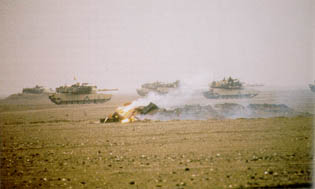
1st Armored Division Elements Passing the Burning Remnants of an
Iraqi Tank
The dust storms had cleared early in the day, revealing in VII Corps' sector the most awesome array of armored and mechanized power fielded since World War II. In a panorama extending beyond visual limits 1,500 tanks, another 1,500 Bradleys and armored personnel carriers, 650 artillery pieces, and supply columns of hundreds of vehicles stretching into the dusty brown distance rolled east through Iraqi positions, as inexorable as a lava flow. To Iraqi units, depleted and demoralized by forty-one days of continuous air assault, Vll Corps' advance appeared irresistible.
Turning on the enemy the full range of its weapons, Vll Corps systematically destroyed Iraqi military power in its sector. About 50 miles east of Al Busayyah, the 1st and 3d Armored Divisions tore into remnants of the Tawalzalaa, Madina, and Adnan Divisions of the Republican Guard. In one of several large engagements along the advance the 2d Brigade, 1st Armored Division, received artillery fire and then proceeded to destroy not only those artillery batteries but also 61 tanks and 34 armored personnel carriers of the Madina Division in less than one hour. The 1st Infantry Division overran the 12th Armored Division and scattered the 10th Armored Division into retreat. On the south flank the British 1st Armored Division destroyed the 52d Armored Division, then overran three infantry divisions. To finish destruction of the Republican Guard Forces Command, General Franks conducted a giant envelopment involving the 1st Cavalry Division on the left and the 1st Infantry Division on the right.
197
The trap closed on disorganized bands of Iraqis streaming north in full retreat. The only setback for VII Corps during this climactic assault occurred in the British sector. American Air Force A-10 Thunderbolt aircraft supporting the British advance mistakenly fired on 2 infantry fighting vehicles, killing 9 British soldiers.46
At 1700 Franks informed his divisions of an imminent theater-wide cease-fire but pressed VII Corps' attack farther east. An hour later the 1st Squadron, 4th Cavalry, 1st Infantry Division, set a blocking position on the north-south highway connecting Al Basrah to Kuwait City. The next morning corps artillery units fired an enormous preparation involving all long-range weapons: 155-mm. and 8-inch (203-mm.) self-propelled pieces, rocket launchers, and tactical missiles. Attack helicopters followed to strike suspected enemy positions. The advance east continued a short time until the cease-fire went into effect at 0800, 28 February, with American armored divisions just inside Kuwait.47
In ninety hours of continuous movement and combat, VII Corps had achieved impressive results against the best units of the Iraqi military. Franks' troops destroyed more than a dozen Iraqi divisions, an estimated 1,300 tanks, 1,200 infantry fighting vehicles and armored personnel carriers, 285 artillery pieces, and 100 air defense systems, and captured nearly 22,000 men. At the same time, the best Iraqi divisions destroyed only 7 MlA1 Abrams tanks, 15 Bradleys, 2 armored personnel carriers, and 1 Apache helicopter. And while killing unknown thousands of enemy troops, VII Corps lost 22 soldiers killed in action.48
In the Marine Central Command's sector on 27 February the Tiger Brigade, 2d Armored Division, and the 2d Marine Division began the fourth day of the ground war by holding positions and maintaining close liaison with Joint Forces Command North units on the left flank. The next phase of operations in Kuwait would see Saudi-commanded units pass through General Boomer's sector from west to east and go on to liberate Kuwait City. At 0550 Tiger troops made contact with Egyptian units, and four hours later Joint Forces Command North columns passed through 2d Marine Division. During the rest of the day Tiger troops cleared bunker complexes, the Ali Al Salem Airfield, and the Kuwaiti Royal Summer Palace, while processing a continuous stream of prisoners of war. The Army brigade and the 2d Marine Division remained on Mutla Ridge and phase line BEAR until the ceasefire went into effect at 0800 on 28 February. Prisoner interrogation during and after combat operations revealed that the Tiger Brigade advance had split the seam between the Iraqi 111 and IV Corps, overrunning elements of the 14th, 7th, and 36th Infantry Divisions, as well as brigades of the 3d Armored, 1st Mechanized, and 2d Infantry Divisions. During four days of combat Tiger Brigade task forces destroyed or captured 181 tanks, 148 armored personnel carriers, 40 artillery pieces, and 27 antiaircraft systems while killing an estimated 263 enemy and capturing 4,051 prisoners of war, all at a cost of 2 killed and 5 wounded. 49
198-199
Map 16 Ground War Situation 27 February 1991
200
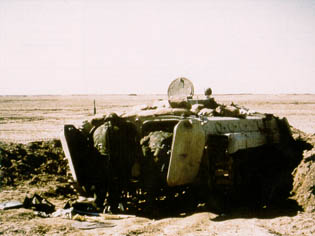 |
|
|
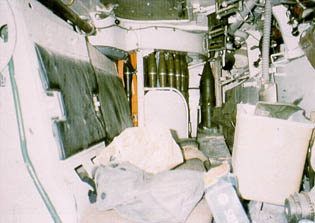 |
201
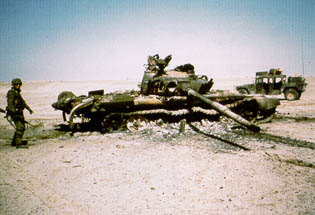
An Iraqi T-72 Tank, penetrated and destroyed by two 120-mm. sabot
rounds
Of the many successful aspects of Army operations in Operation DESERT STORM, three stand out. First, Army units moved so fast that they found their enemy consistently out of position and oriented in the wrong direction. In 100 hours of combat XVIII Airborne Corps moved its lead elements 190 miles north into Iraq and then 70 miles east. Even the armor-heavy Vll Corps drove 100 miles into Iraq and then 55 miles east. Iraqi units showed themselves unable to reposition even short distances before Army units were upon them.
Second, American forces enjoyed substantial technological advantages, most notably in night vision and electro-optics. Two types of vision-enhancing technology had been incorporated into Army operations preceding the deployment to the Persian Gulf. One of these aids to vision represented advanced development of a device first field tested during the Vietnam War, the image intensification system known as
202
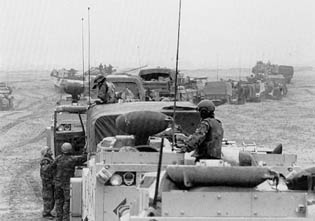
On the Kuwaiti Border Moments After the Cease-fire
Starlight. Gathering and concentrating the faint light of the moon and stars, Starlight offered a view of terrain out to about 100 yards in shades similar to a photographic negative. It did not depend on a transmitted beam that an adversary could detect. Still, it had drawbacks, among them the system's need for a clear night as well as expense, weight, and size. So the early Starlight scopes had been distributed only to specialized units, such as long-range patrol and sniper teams.
By 1991 image intensification systems had been refined to the point that small lightweight units could be used by individual soldiers, in the forms of night vision goggles and weapon sights. Among an entire family of night vision and electro-optical devices, three particular types showed the wide battlefield applicability of the technology. The AN/PVS-4 individual-served weapon sight could be used with the M16 rifle, the M60 machine gun, the M72 rocket launcher, and the M203 grenade launcher. Detached from these weapons, the sight offered commanders the ability to carry out night surveillance. The AN/PVS-7 night vision goggle was a head-mounted monocular unit for ground vehicle operation, map reading, navigation, maintenance, and first aid. The AN/AVS-6 aviation night vision imaging system was a binocular system that allowed helicopter pilots to conduct nocturnal missions as close to the ground as possible.51
Another category of vision enhancement technology-thermal imaging-avoided the need of image intensification systems for clear night skies and retained the advantage of passivity. By reading the heat signatures of vehicle engines and human bodies at distances beyond 2 miles, thermal-imaging systems penetrated visual barriers created by nighttime, dust storms, and rain or snow. These systems proved particularly useful on MlA1 tanks, Bradleys, TOW missile launchers, and Apache
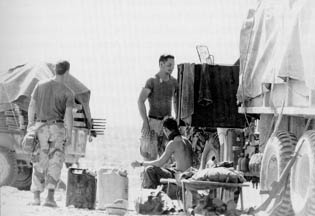
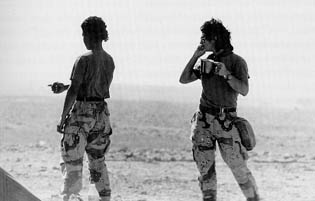
The Day After the War. Soldiers relax at forward operating base
COBRA
helicopters. When combined with laser range-finding systems on armored vehicles, thermal imaging gave crews the ability to fire on targets-the troops called them "hot spots"-before the enemy even knew they were there.52
Soldiers at all levels enthusiastically praised all of the imagery devices. American troops were able to carry out night or day combat operations with virtually the same efficiency. This equipment vastly surpassed the obsolescent Soviet equipment used by the Iraqis and overturned the age-old assumption that the force fighting on its own territory had an inherent advantage. By seeing the heat signatures of Iraqi tanks and other vehicles on their thermal-imaging scopes before their own appeared on Iraqi scopes, Americans could engage targets in heavy rain, dust storms, and darkness. So, throughout the ground war the Iraqis, on their own familiar territory, were continually subjected to accurate fire in conditions, at distances, and from directions they did not expect.53
Other products of advanced technology contributed significantly to success. Two location and navigation devices, named Trimpack and Magellan by their manufacturers, minimized disorientation on the ground, a perennially serious problem that was magnified by the featureless desert environs of Southwest Asia. Trimpack (officially called the small lightweight global positioning system receiver) was dubbed "Slugger" by the troops. Both devices weighed about six pounds and were small enough to fit in a pack. They had solid-state electronics that read transmissions from orbiting satellites and gave their users precise coordinate locations. Both also determined firing data for artillery units, corrected azimuth bearings to objectives, and measured angles of descent for aircraft heading for landing zones or targets. Magellan and Trimpack rendered the age-old problems of map or terrain-reading errors obsolete.
204
Among weapons, the AH-64A Apache attack helicopter, armed with HELLFIRE missiles, belied its reputation as an overly complex, breakdown-prone system. The Apache proved a highly effective tank killer. The multiple launch rocket system and Army tactical missile system demonstrated great effect against entrenched enemy and in counterbattery missions in their own right. When combined with the Firefinder device to locate the source of enemy fire, the rocket and missile systems suppressed Iraqi artillery fire quickly and permanently. Because of the Firefinder advantage, enemy batteries were rarely heard from in XVIII Airborne Corps' sector after the first two days of the conflict, a great relief to Army commanders concerned about one of the few advantages of the Iraqis-the greater range of their newer artillery. The older mainstays of Army artillery, 155-mm. and 8-inch (203-mm.) pieces, underlined their well-founded reputations as accurate and dependable direct support systems.54
Just as impressive as the high-technology Army inventory at the beginning of the crisis in late 1990 was the ability of American defense agencies to answer demands from Central Command for new products. A dramatic example of this response capability came in the days before the ground war. The successful allied counterattack on the city of R'as al Khafji in the first week of February was marred when American support fire killed several CENTCOM troops. General Schwarzkopf ordered accelerated research on antifratricide methods. A joint research team, coordinated by the Defense Advanced Research Projects Agency, immediately went to work on the problem of making American vehicles and positions visible only to American armored vehicles and aircraft. Just nineteen days later Central Command distributed the results of the agency's work: On the Army side of the research effort the Center for Night Vision and Electro-Optics at Fort Belvoir, Virginia, came up with the Budd Light and over twenty other solutions to the problem, some of which were fielded before the end of the war.55
Third, American soldiers outperformed their Iraqi enemies. Particularly gratifying to higher-echelon commanders was the conduct of personnel in the all-important middle-level action positions: junior officers and noncommissioned officers. Those were the lieutenants and sergeants who took the initiative to lead convoys across dangerous desert expanses at night to resupply the advance; found and engaged thousands of enemy tanks and positions in the confusion of heavy rains and blinding dust storms; and, when called for, treated a defeated enemy with dignity and care. As General McCaffrey observed of his junior officers and noncommissioned officers during the 24th Division's dash to the Euphrates River valley, "They could have done it without us."56
The impressive overall performance notwithstanding, problems requiring postwar attention did occur. Several types of equipment drew criticism from commanders. American field radios proved unreliable, and commanders who had the opportunity to try British-made Iraqi radios
205
pronounced them superior. Fortunately, the initiative of key commissioned and enlisted personnel at the battalion and company levels bridged communications gaps at crucial times. In a curious split decision on a weapon, the M109 155-mm. field artillery piece won praise for fire effect on targets, but its self-propelling component proved underpowered to keep pace with mechanized and armored assaults. One piece of combat engineer equipment earned similar criticism. The M9 armored combat earthmover cut through berms easily but could not keep up with assaults over open terrain.
Despite its brevity, the 100-hour Persian Gulf war lasted long enough to provoke an update of the age-old postwar lament, criticism of the supply effort. This time, the speed of the advance exposed a shortcoming: helicopters, tanks, and Bradleys outdistanced supply trucks. Lifting fuel tanks and ammunition pallets by helicopter provided a quick fix, but choppers carrying fuel gulped it almost as fast as they delivered it. If the ground war had lasted longer, General Schwarzkopf would have had to halt the advance to fill forward operating bases. On the morning of 27 February, as Vll Corps prepared to complete the destruction of the Republican Guard Forces Command, 1st and 3d Armored Division tanks were almost out of fuel.57
After isolating and evaluating various aspects of Army operations and systems, questions remained about the overall course of the war and its outcome. Was the Army really as good as the overwhelming victory and one-sided statistics of the war suggested? Was Iraq's military really that weak? Complete answers awaited more careful analysis of the combatants, but in the immediate aftermath of the ground campaign two conclusions seemed justified.
First, Iraq's military was not prepared for a war of rapid movement over great distances. The Iraqis, in their most recent combat experience against Iran, had developed skills at slow-paced, defense-oriented warfare. Those skills proved inadequate to stop an army with high-speed armor capabilities.
Second, Central Command used its air arm to devastating advantage. With air supremacy established more than a month before the ground war began, the success of General Schwarzkopf's well-conceived and dreadfully misnamed "Hail Mary" play-the huge corps-size envelopment to the west-was assured. The relentless day and night pounding of aerial bombardment made easier the task of coalition units not in the envelopment, for when they attacked straight ahead into Iraqi positions, they found enemy units less than 50-percent effective. The combination of a powerful air offensive, followed by a fast moving armor-reinforced ground campaign, proved extremely effective in the desert environs of Southwest Asia.
Notes
1 Unless otherwise noted, material in this chapter is based on U.S. Department of Defense, Conduct of the Persian Gulf War, An Interim Report to Congress (Washington, D.C.: Government Printing Office, 1991), p. 4-6, Third U.S. Army, After Action Review, 12 Mar 91, Draft MS, Swain, Operational Narrative, and Robert H. Scales, Jr., Certain Victory: The United States Army in the Gulf War (Washington, D.C.: Office of the Chief of Staff, United States Army, 1993).
2 Army Focus, Jun 91, p. 22.
3 XVIII Airborne Corps Sitrep, 24 Feb 91, Peter David, Triumph in the Desert (New York: Random House, 1991), p. 78; Interv (telephone), Charles R. Anderson with Maj. Robert K. Wright, command historian, XVIII Airborne Corps, May 91.
4 Army Times, 11 Mar 91, p. 15; Wright interview.
5 Ibid.
6 Wright interview.
7 Ibid.
8 Desert Shield and Desert Storm Operations Overview, 9 May 1991, prepared for United States Senate Armed Services Committee, Document no. 77 in HQ, 24th Infantry Division (Mech.), Historical Reference Book (Fort Stewart, Ga., 1992), copy in CMH.
9 Interv, Maj. William H. Thomas III with Lt. Col. Edwin W. Chamberlain III, commander, 1/18th Infantry, 197th Infantry Brigade, 24th Infantry Division (Mech.), 16 May 91.
10 Interv, Charles R. Anderson with Walter B. Morrow, Center for Night Vision and Electro-Optics, U.S. Army Communications-Electronics Command, Fort Belvoir, Va., 2 Jul 92.
11 MS, Doughty, War in the Persian Gulf, p. 15; Draft MS, Carver, Narrative of VII Corps in Operation DESERT STORM, pp. 3-4.
12 Army Focus, Jun 91, p. 22; Washington Post, 12 and 13 Sep 91; 1st Infantry Division (Mech.), Operations DESERT SHIELD and DESERT STORM Command Rpt, 19 Apr 91, p. 4; VII Corps Commander's Sitrep (Combat) 38, 24 Feb 91.
13 VII Corps Sitrep, 24 Feb 91; MS, Maj. Guy C. Swan, 1st Armored Division in Combat, 21-28 February 1991, p. 1; Draft MS, Carver, Narrative of VII Corps in Operation DESERT STORM, p. 4.
14 Army Times, 11 Mar 91, pp. 14-15, Lt. Gen. Walter E. Boomer, Command Brief: Persian Gulf Campaign, U.S. Marine Corps Operations, n.d.; Intervs, Charles R. Anderson with Lt. Col. Ronald J. Brown, U.S. Marine Corps Reserve (USMCR) and Maj. Charles D. Melson (USMC, U.S. Marine Corps History and Museums Division, 2 Jul 91, Washington, D.C.
15 1st Brigade, 2d Armored Division, Commander's Summary, n.d.
16 Brown interview.
17 Boomer, Command Brief: Persian Gulf Campaign; U.S. Marine Corps Operations, n.d. , Army Times, 11 Mar 91, p. 15.
18 Third U.S. Army, After Action Review, 12 Mar 91.
19 Maj. Gen. Barry R. McCaffrey, 24th Infantry Division (Mech.): Operation DESERT STORM Post-Attack Summary, 18 Mar 91.
20 Ibid.; Interv, Maj. William H. Thomas III with Col. John Lemoyne, commander, 1st Brigade, 24th Infantry Division (Mech.), 7 Mar 91; XVIII Airborne Corps Sitrep, 25 Feb 91.
21 VII Corps, Desert Sabre Operations Summary.
22 Ltr, Mal Paul J. Jacobsmeyer to Col. K. Hamburger, Department of History, USMA, 7 Mar 91.
23 VII Corps, Desert Sabre Operations Summary, VII Corps Commander's Sitrep (Combat) 39, 25 Feb 91.
24 MS, Swan, 1st Armored Division in Combat, 21-28 February 1991, p. 1, Ltr, Capt. Kevin McKedy to "Dear Mil [sic] Artists," 9 Mar 91.
25 Army Times, 11 Mar 91, p. 14.
26 Brown interview; 1st Brigade, 2d Armored Division, Commanderís Summary, n.d.
27 ODCSINT Intelligence Summaries 404, 25 Feb 91, and 406, 26 Feb 91.
28 McCaffrey, 24th Infantry Division (Mech.): Operation DESERT STORM Post-Attack Summary, 18 Mar 91, Lemoyne interview.
29 Ibid.; Wright interview.
30 VII Corps Sitrep, 27 Feb 91 VII Corps Commander's Sitrep (Combat) 40, 26 Feb 91; 1st Armored Division Executive Summary-Operation DESERT STORM, 19 Apr 91.
31 VII Corps Sitrep, 27 Feb 91; VII Corps Commander's Sitrep (Combat) 40, 26 Feb 91; Third U.S. Army, After Action Review, 12 Mar 91; 1st Infantry Division (Mech.), Operations DESERT SHIELD and DESERT STORM Command Rpt, 19 Apr 91, p. 5; 3d Armored Division, Historical Overview of the 3AD in the Persian Gulf War, p. 10.
32 Memo, Col. Michael D. Krause for Gen. Gordon R. Sullivan, 19 Apr 91, sub: Battle of 73 Easting.
33 Ibid., VII Corps Sitrep, 27 Feb 91.
34 VII Corps Sitrep, 27 Feb 91; VII Corps Commander's Sitrep (Combat) 40, 26 Feb 91; VII Corps, Desert Sabre Operations Summary; VII Corps DESERT SHIELD/DESERT STORM After Action Rpt, 29 May 91.
35 Brown interview.
36 Boomer, Command Brief: Persian Gulf Campaign; U.S. Marine Corps Operations, n.d., 1st Brigade, 2d Armored Division, Commander's Summary, n.d.
37 Brown interview.
38 ODCSINT Intelligence Summaries 406, 26 Feb 91, and 408, 27 Feb 91.
39 Interv, S Sgt. Warren B. Causey, 317th Military History Detachment, with Lt. Col. Raymond Barrett, commander, 3/15th Infantry, 2d Brigade, 24th Infantry Division, 1 Mar 91,
40 Ibid.
41 McCaffrey, 24th Infantry Division (Mech.): Operation DESERT STORM Post-Attack Summary, 18 Mar 91.
42 Ibid.
43 Ibid.; Interv, Maj. William H. Thomas with Maj. Gen. Barry R. McCaffrey, 28 Feb 91, Interv, Thomas with Lt. Col. David Jensen, commander, 3/7th Infantry, 1st Brigade, 24th Infantry Division, 9 Mar 91.
44 Ibid.; Wright interview.
45 Third U.S. Army, After Action Review, 12 Mar 91.
46 Ibid., MS, Swan, 1st Armored Division in Combat, 21-28 February 1991, pp. 2-3; MS, VII Corps Public Affairs Office, VII Corps DESERT STORM History, p. 5; VII Corps, Desert Sabre Operations Summary; VII Corps Commander's Sitrep (Combat) 41, 27 Feb 91; 1st Armored Division Executive Summary-Operation DESERT STORM, 19 Apr 91.
47 MS, Doughty, War in the Persian Gulf, p. 16, MS, Swan, 1st Armored Division in Combat, 21-28 February 1991, p. 3.
48 MS, Doughty, War in the Persian Gulf, p. 17; MS, Carver, Narrative of VII Corps in Operation DESERT STORM, p. 7.
49 Boomer, Command Brief: Persian Gulf Campaign; U.S. Marine Corps Operations, n.d., 1st Brigade, 2d Armored Division, Commander's Summary, n.d.
50 Third U.S. Army, After Action Review, 12 Mar 91; ODCSINT Intelligence Summary 412, 1 Mar
91; Washington Post, 13 Jun 91.
51 Ibid.; Wright interview.
52 VII Corps Sitrep, 27 Feb 91.
53 MS, Lt. Col. Gregory Fontenot, commander, 2/34th Armor, Attack on Objective NORFOLK, 26 Mar 91, p.1.
54 Wright interview.
55 John F. Morton, "DARPA, Industry Fielded Antifratricide Device in 19 Days," Armed Forces Journal International (May 1991): 58, 60; Interv, Charles R. Anderson with Walter B. Morrow, Center for Night Vision and Electro-Optics, 27 Jun 91, Fort Belvoir, Va.
56 McCaffrey interview.
57 Ibid.; Chamberlain interview; Memo, Lt. Col. Fontenot, 8 Mar 91, sub: Operation DESERT STORM After Action Report; MS, Swan, 1st Armored Division in Combat, 21-28 February 1991, p. 2.
page updated 7 June 2001
Return to the Table of Contents